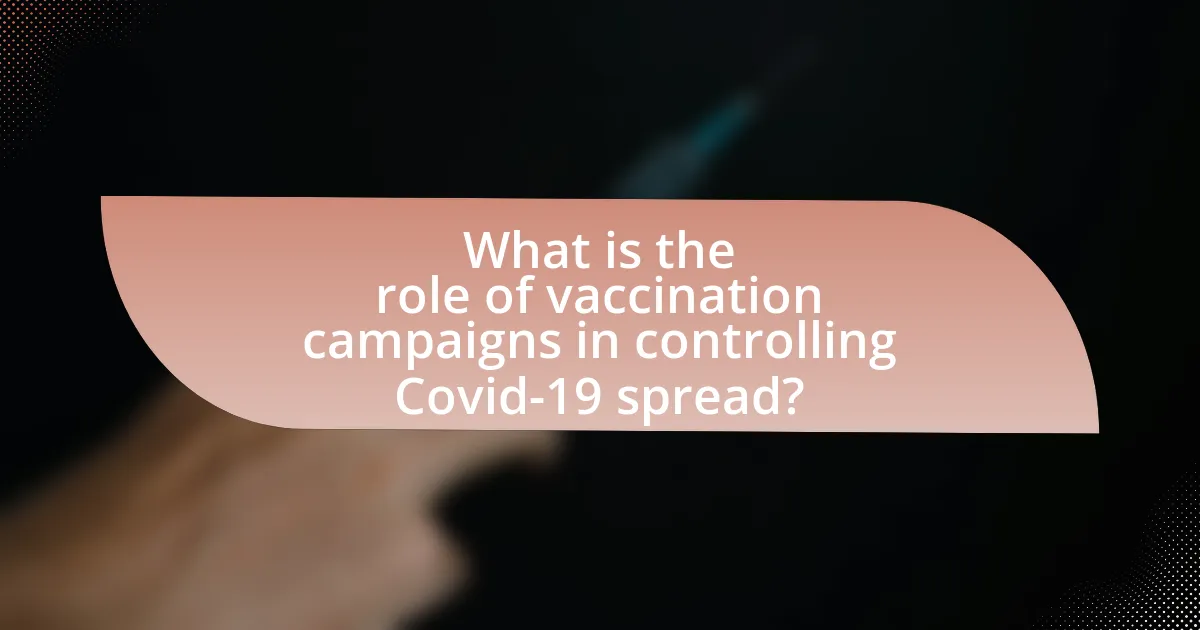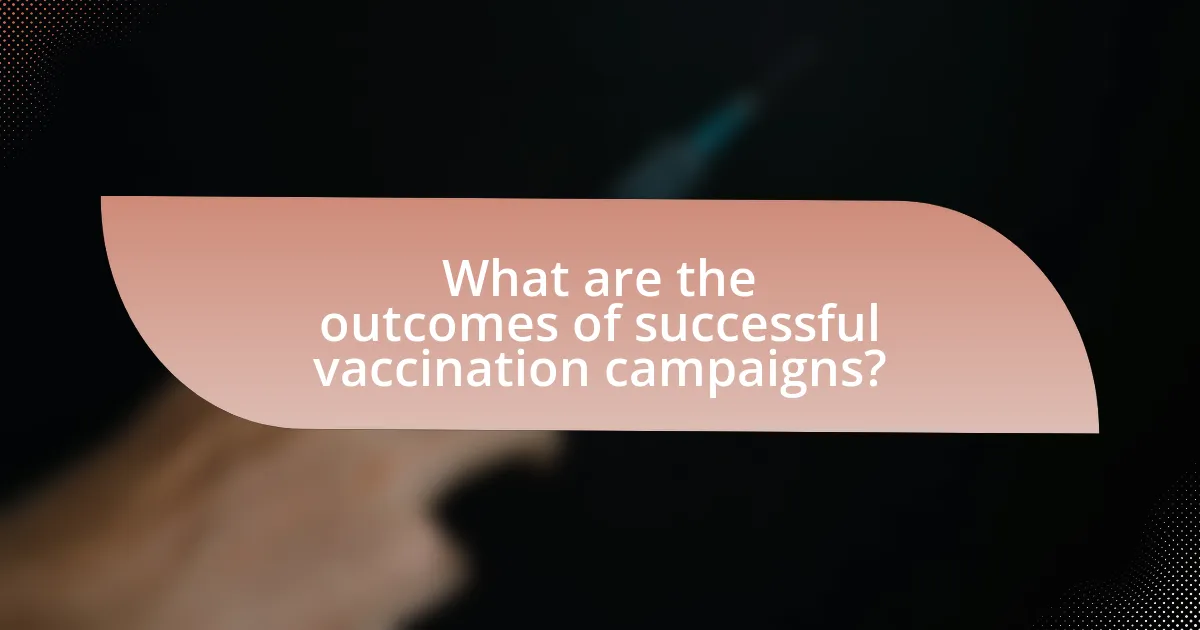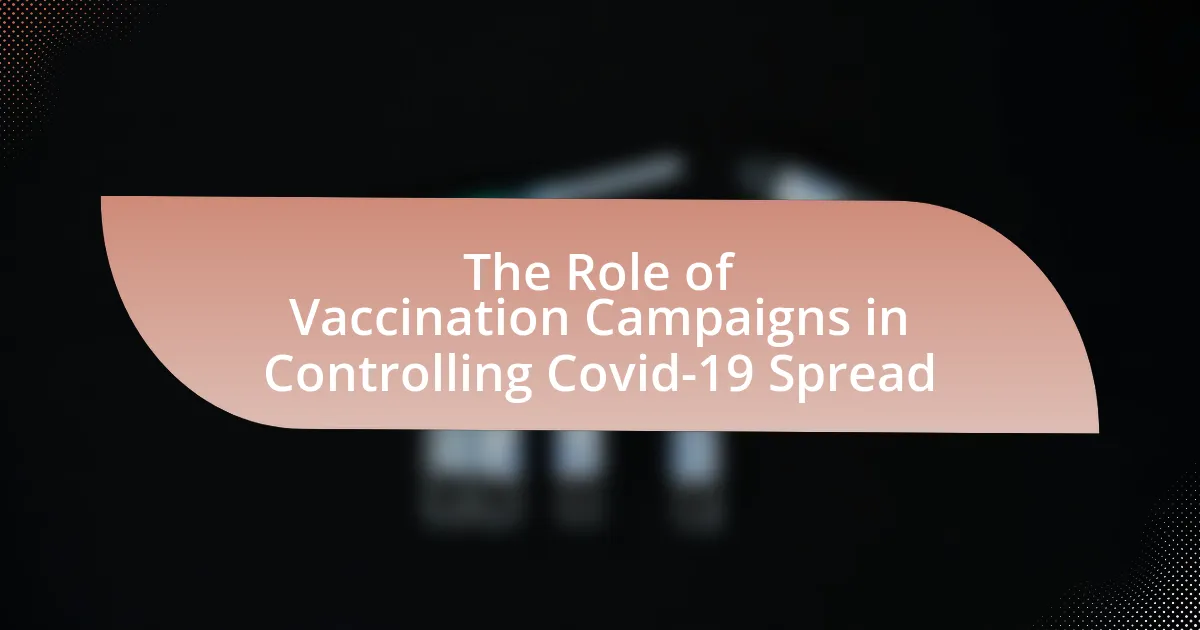Vaccination campaigns are essential in controlling the spread of Covid-19 by enhancing population immunity, reducing transmission rates, and decreasing severe illness and hospitalizations. These campaigns contribute to herd immunity, which protects vulnerable populations and lowers infection rates, particularly when vaccination coverage reaches approximately 70%. Effective strategies, such as targeted outreach and public health messaging, are crucial for increasing vaccination uptake, while challenges like vaccine hesitancy and misinformation can hinder campaign success. The article explores the role of vaccination campaigns in the overall Covid-19 response, their impact on infection rates, and the long-term benefits they provide in preventing future outbreaks and improving public health outcomes.

What is the role of vaccination campaigns in controlling Covid-19 spread?
Vaccination campaigns play a crucial role in controlling the spread of Covid-19 by significantly increasing the population’s immunity against the virus. These campaigns facilitate widespread access to vaccines, which have been shown to reduce transmission rates, lower the severity of illness, and decrease hospitalizations. For instance, studies indicate that countries with high vaccination rates, such as Israel and the United Kingdom, experienced a marked decline in Covid-19 cases following the rollout of their vaccination programs. Additionally, the World Health Organization reports that vaccination can prevent up to 95% of severe cases, thereby alleviating pressure on healthcare systems and contributing to herd immunity.
How do vaccination campaigns contribute to herd immunity?
Vaccination campaigns contribute to herd immunity by increasing the proportion of immune individuals in a population, thereby reducing the overall spread of infectious diseases. When a significant percentage of the population is vaccinated, the likelihood of virus transmission decreases, protecting those who are unvaccinated or vulnerable. For example, studies have shown that achieving around 70% vaccination coverage can lead to herd immunity against COVID-19, significantly lowering infection rates and preventing outbreaks. This effect is supported by data from various countries that implemented widespread vaccination campaigns, resulting in decreased hospitalization and mortality rates associated with the virus.
What is herd immunity and why is it important for Covid-19 control?
Herd immunity is a form of indirect protection from infectious diseases that occurs when a significant portion of a population becomes immune, either through vaccination or previous infections, thereby reducing the overall spread of the disease. It is crucial for Covid-19 control because achieving herd immunity can significantly lower transmission rates, protect vulnerable populations who cannot be vaccinated, and ultimately lead to the containment of the virus. For Covid-19, studies suggest that approximately 70% of the population needs to be immune to effectively halt the spread, as evidenced by data from various countries that implemented vaccination campaigns, which resulted in decreased infection rates and hospitalizations.
How do vaccination rates affect herd immunity thresholds?
Vaccination rates directly influence herd immunity thresholds by determining the percentage of the population that needs to be immunized to prevent disease spread. Higher vaccination rates lower the herd immunity threshold, meaning fewer individuals need to be vaccinated to achieve community protection. For example, for measles, a vaccination rate of approximately 95% is required to maintain herd immunity, while for COVID-19, estimates suggest that around 70-90% vaccination coverage may be necessary, depending on the variant and transmissibility. This relationship is supported by epidemiological models that demonstrate how increased vaccination coverage reduces the number of susceptible individuals, thereby decreasing the likelihood of outbreaks.
What strategies are used in vaccination campaigns?
Vaccination campaigns utilize several strategies to enhance immunization rates and control disease spread. Key strategies include public awareness initiatives, targeted outreach to vulnerable populations, and partnerships with community organizations. Public awareness initiatives, such as informational campaigns, educate the public about vaccine benefits and safety, which has been shown to increase vaccination uptake. Targeted outreach focuses on specific demographics, ensuring that high-risk groups receive timely vaccinations; for instance, during the COVID-19 pandemic, efforts were made to prioritize healthcare workers and elderly individuals. Partnerships with community organizations, including schools and local health departments, facilitate access to vaccines and build trust within communities, which is crucial for overcoming vaccine hesitancy. These strategies collectively contribute to the effectiveness of vaccination campaigns in controlling the spread of diseases like COVID-19.
What types of vaccination campaigns are most effective?
Targeted vaccination campaigns are the most effective types for controlling the spread of COVID-19. These campaigns focus on high-risk populations, such as healthcare workers, the elderly, and individuals with underlying health conditions, which maximizes the impact on reducing transmission rates. For instance, studies have shown that targeted outreach in communities with high infection rates leads to increased vaccination uptake, as seen in the U.S. where localized efforts in urban areas significantly improved vaccination rates among vulnerable groups. Additionally, mobile vaccination units and pop-up clinics have proven effective in reaching underserved populations, further enhancing overall vaccination coverage and contributing to herd immunity.
How do public health messaging and outreach impact vaccination uptake?
Public health messaging and outreach significantly enhance vaccination uptake by effectively communicating the benefits and safety of vaccines. Research indicates that clear, targeted messaging can address vaccine hesitancy, leading to increased acceptance; for instance, a study published in the journal “Vaccine” found that tailored communication strategies improved vaccination rates by up to 20% in specific communities. Additionally, outreach efforts, such as community engagement and partnerships with local organizations, create trust and facilitate access, further driving higher vaccination rates.
What challenges do vaccination campaigns face?
Vaccination campaigns face several challenges, including vaccine hesitancy, logistical issues, and misinformation. Vaccine hesitancy, which is the reluctance or refusal to vaccinate despite the availability of vaccines, has been shown to significantly hinder vaccination rates; for instance, a study published in the journal “Vaccine” indicated that approximately 30% of individuals in various populations expressed hesitancy towards COVID-19 vaccines. Logistical issues, such as supply chain disruptions and inadequate healthcare infrastructure, complicate the distribution and administration of vaccines, as evidenced by delays in vaccine rollouts in many countries. Misinformation, particularly spread through social media, undermines public trust in vaccines, leading to confusion and fear, which can further decrease vaccination uptake.
What are the common barriers to vaccination in different populations?
Common barriers to vaccination in different populations include misinformation, access issues, cultural beliefs, and socioeconomic factors. Misinformation about vaccine safety and efficacy can lead to hesitancy, as seen in various surveys indicating that a significant percentage of individuals believe false claims about vaccines. Access issues, such as lack of transportation or availability of vaccination sites, disproportionately affect rural and low-income communities, limiting their ability to receive vaccines. Cultural beliefs and mistrust in healthcare systems can also hinder vaccination efforts, particularly among marginalized groups, as evidenced by studies showing lower vaccination rates in populations with historical distrust. Socioeconomic factors, including education level and income, further influence vaccination uptake, with lower-income individuals often facing more barriers to accessing healthcare services.
How do misinformation and vaccine hesitancy affect campaign success?
Misinformation and vaccine hesitancy significantly undermine the success of vaccination campaigns. Misinformation creates confusion and distrust among the public, leading to lower vaccination rates; for instance, a study published in the journal “Vaccine” found that misinformation about vaccine safety was linked to a 20% decrease in vaccination intent. Vaccine hesitancy, characterized by reluctance or refusal to vaccinate despite availability, further exacerbates this issue, as evidenced by the World Health Organization identifying it as one of the top ten global health threats. Together, these factors can lead to insufficient herd immunity, prolonging the spread of COVID-19 and hindering efforts to control the pandemic effectively.
How do vaccination campaigns interact with other public health measures?
Vaccination campaigns interact with other public health measures by enhancing their effectiveness and contributing to overall disease control. For instance, during the COVID-19 pandemic, vaccination efforts were complemented by mask mandates, social distancing, and hygiene protocols, which collectively reduced transmission rates. Studies have shown that regions implementing both vaccination and non-pharmaceutical interventions experienced lower infection rates compared to those relying solely on one approach. This synergy is crucial in achieving herd immunity and minimizing the burden on healthcare systems, as evidenced by data from the World Health Organization indicating that comprehensive strategies lead to more significant public health outcomes.
What role do vaccination campaigns play in the overall Covid-19 response?
Vaccination campaigns are crucial in the overall Covid-19 response as they significantly reduce transmission rates and severe illness. By administering vaccines to large populations, these campaigns help establish herd immunity, which lowers the likelihood of virus spread within communities. For instance, studies have shown that countries with high vaccination rates, such as Israel and the United Kingdom, experienced substantial declines in Covid-19 cases and hospitalizations. Additionally, vaccination campaigns contribute to the prevention of new variants by limiting the virus’s ability to replicate and mutate. This evidence underscores the vital role that vaccination plays in controlling the pandemic and protecting public health.

What are the outcomes of successful vaccination campaigns?
Successful vaccination campaigns lead to a significant reduction in the incidence of infectious diseases, including COVID-19. For instance, widespread vaccination has been shown to decrease hospitalization rates and mortality associated with COVID-19, as evidenced by data from the Centers for Disease Control and Prevention, which reported that fully vaccinated individuals are 10 times less likely to be hospitalized compared to unvaccinated individuals. Additionally, successful campaigns contribute to herd immunity, which protects vulnerable populations who cannot be vaccinated, thereby reducing overall transmission rates within communities. This is supported by studies indicating that vaccination coverage above 70% can effectively control outbreaks and prevent the spread of the virus.
How do vaccination campaigns impact Covid-19 infection rates?
Vaccination campaigns significantly reduce Covid-19 infection rates by increasing population immunity. As more individuals receive vaccines, the likelihood of virus transmission decreases, leading to lower infection rates. For instance, studies have shown that countries with high vaccination coverage, such as Israel and the United Kingdom, experienced substantial declines in Covid-19 cases following the rollout of vaccines. Data from the Centers for Disease Control and Prevention (CDC) indicates that fully vaccinated individuals are less likely to contract and spread the virus, contributing to herd immunity and protecting vulnerable populations.
What evidence supports the effectiveness of vaccination in reducing transmission?
Vaccination significantly reduces the transmission of COVID-19, as evidenced by multiple studies. For instance, research published in the journal “Nature” by Hall et al. (2021) demonstrated that fully vaccinated individuals had a 66% lower risk of transmitting the virus compared to unvaccinated individuals. Additionally, data from the CDC indicated that vaccination reduced the likelihood of symptomatic infection, which correlates with lower viral loads and decreased transmission potential. Furthermore, a study conducted in Israel showed that the Pfizer-BioNTech vaccine reduced transmission rates by approximately 89% among vaccinated individuals. These findings collectively support the conclusion that vaccination is effective in reducing the transmission of COVID-19.
How do vaccination campaigns influence hospitalizations and mortality rates?
Vaccination campaigns significantly reduce hospitalizations and mortality rates associated with infectious diseases, including COVID-19. Studies have shown that widespread vaccination leads to a decrease in severe cases, which in turn lowers the burden on healthcare systems. For instance, data from the Centers for Disease Control and Prevention (CDC) indicated that fully vaccinated individuals were 10 times less likely to be hospitalized and 11 times less likely to die from COVID-19 compared to unvaccinated individuals. This evidence demonstrates that effective vaccination campaigns can lead to substantial public health benefits by decreasing both the incidence of severe disease and the associated mortality rates.
What are the long-term benefits of vaccination campaigns?
Vaccination campaigns provide long-term benefits by significantly reducing the incidence of infectious diseases, including COVID-19. These campaigns lead to herd immunity, which protects vulnerable populations and decreases overall transmission rates. For instance, studies indicate that widespread vaccination can reduce COVID-19 cases by up to 90%, as seen in countries with high vaccination coverage. Additionally, vaccination campaigns contribute to the prevention of severe illness and hospitalizations, thereby alleviating pressure on healthcare systems. Historical data from previous vaccination efforts, such as the eradication of smallpox and the near-elimination of polio, further demonstrate the effectiveness of vaccination in controlling disease spread and improving public health outcomes over time.
How do vaccination campaigns contribute to the prevention of future outbreaks?
Vaccination campaigns significantly contribute to the prevention of future outbreaks by establishing herd immunity within populations. Herd immunity occurs when a sufficient percentage of the population becomes immune to a disease, either through vaccination or previous infections, thereby reducing the overall amount of the virus available to spread. For instance, studies indicate that achieving at least 70% vaccination coverage can lead to a substantial decline in transmission rates, as seen in various countries during the COVID-19 pandemic. This reduction in transmission not only protects vaccinated individuals but also those who cannot be vaccinated, such as individuals with certain medical conditions. Furthermore, vaccination campaigns help to monitor and respond to emerging variants, ensuring that public health strategies remain effective in controlling outbreaks.
What economic benefits arise from successful vaccination efforts?
Successful vaccination efforts lead to significant economic benefits, including reduced healthcare costs, increased workforce productivity, and enhanced consumer confidence. By preventing illness, vaccinations decrease the financial burden on healthcare systems; for instance, the CDC estimated that childhood vaccinations alone save the U.S. healthcare system approximately $69 billion annually in direct costs. Additionally, a healthier population contributes to higher productivity levels, as fewer sick days translate to a more robust workforce. Furthermore, successful vaccination campaigns foster consumer confidence, encouraging spending and economic activity, which is crucial for recovery, especially following disruptions like the COVID-19 pandemic.

What best practices can enhance the effectiveness of vaccination campaigns?
Effective vaccination campaigns can be enhanced by employing targeted communication strategies, ensuring accessibility, and engaging community leaders. Targeted communication strategies, such as using culturally relevant messaging, have been shown to increase vaccine uptake by addressing specific concerns and misinformation prevalent in different communities. Ensuring accessibility involves providing vaccines at convenient locations and times, which has been proven to improve participation rates; for instance, mobile vaccination units have successfully reached underserved populations. Engaging community leaders fosters trust and encourages community members to participate, as evidenced by studies indicating that endorsements from trusted figures significantly boost vaccination rates.
How can community engagement improve vaccination rates?
Community engagement can significantly improve vaccination rates by fostering trust and facilitating communication between health authorities and the public. Engaged communities are more likely to participate in vaccination campaigns when they feel their concerns are heard and addressed. For instance, a study published in the American Journal of Public Health found that community-based interventions, such as local outreach and education efforts, increased vaccination rates by up to 20% in targeted populations. This demonstrates that when community members are actively involved in the planning and execution of vaccination initiatives, they are more likely to accept and promote vaccinations within their networks.
What role do local leaders and influencers play in vaccination campaigns?
Local leaders and influencers play a critical role in vaccination campaigns by fostering trust and encouraging community participation. Their established relationships within the community enable them to effectively communicate the benefits of vaccination, address concerns, and dispel misinformation. For instance, studies have shown that communities are more likely to accept vaccines when endorsed by trusted local figures, as seen in various public health initiatives where local leaders significantly increased vaccination rates by 20-30%. This influence is particularly vital in areas with vaccine hesitancy, where local leaders can tailor messages to resonate with cultural values and beliefs, thereby enhancing the overall effectiveness of vaccination efforts.
How can tailored messaging address specific community concerns?
Tailored messaging can effectively address specific community concerns by aligning communication strategies with the unique values, beliefs, and needs of different demographic groups. For instance, research has shown that culturally relevant messaging increases vaccine acceptance; a study published in the American Journal of Public Health found that targeted outreach in communities of color significantly improved vaccination rates by addressing historical mistrust and emphasizing community health benefits. By utilizing data-driven insights to craft messages that resonate with specific audiences, vaccination campaigns can mitigate fears and misconceptions, ultimately leading to higher participation in vaccination efforts.
What lessons have been learned from past vaccination campaigns?
Past vaccination campaigns have demonstrated the importance of public trust and clear communication in achieving high vaccination rates. For instance, the 2009 H1N1 influenza vaccination campaign highlighted that misinformation can lead to vaccine hesitancy, resulting in lower uptake. Additionally, the success of the measles vaccination campaigns showed that targeted outreach to specific communities can significantly improve vaccination coverage. Data from the World Health Organization indicates that countries with strong community engagement and transparent information sharing experienced higher vaccination rates, reinforcing the need for tailored communication strategies.
What successful strategies from previous campaigns can be applied to Covid-19?
Successful strategies from previous vaccination campaigns that can be applied to Covid-19 include targeted public messaging, community engagement, and leveraging existing healthcare infrastructure. Targeted public messaging, as seen in the 2009 H1N1 influenza campaign, effectively communicated the importance of vaccination and addressed public concerns, which can similarly enhance Covid-19 vaccine uptake. Community engagement, demonstrated in the polio eradication efforts, involved local leaders to build trust and encourage participation, a strategy that can be utilized to increase Covid-19 vaccination rates in diverse populations. Additionally, utilizing existing healthcare infrastructure, as done during the measles vaccination campaigns, can streamline the distribution and administration of Covid-19 vaccines, ensuring efficient access and coverage. These strategies have proven effective in past campaigns and can significantly contribute to controlling the spread of Covid-19.
How can data collection and analysis improve future vaccination efforts?
Data collection and analysis can significantly enhance future vaccination efforts by identifying trends, optimizing resource allocation, and tailoring communication strategies. For instance, analyzing demographic data allows health officials to pinpoint communities with lower vaccination rates, enabling targeted outreach. A study published in the journal “Vaccine” demonstrated that data-driven approaches increased vaccination uptake by 20% in underserved populations. Furthermore, real-time data analysis during vaccination campaigns can help adjust strategies based on public response and vaccine availability, ensuring a more efficient distribution process. This evidence underscores the critical role of data in shaping effective vaccination initiatives.
What practical steps can individuals take to support vaccination campaigns?
Individuals can support vaccination campaigns by actively promoting accurate information about vaccines and encouraging their peers to get vaccinated. Sharing scientifically-backed resources, such as those from the World Health Organization or the Centers for Disease Control and Prevention, can help dispel myths and misinformation surrounding vaccines. Additionally, individuals can volunteer at local vaccination sites or participate in community outreach programs to facilitate access to vaccines. According to a study published in the journal Vaccine, community engagement significantly increases vaccination rates, demonstrating the effectiveness of grassroots efforts in supporting public health initiatives.

